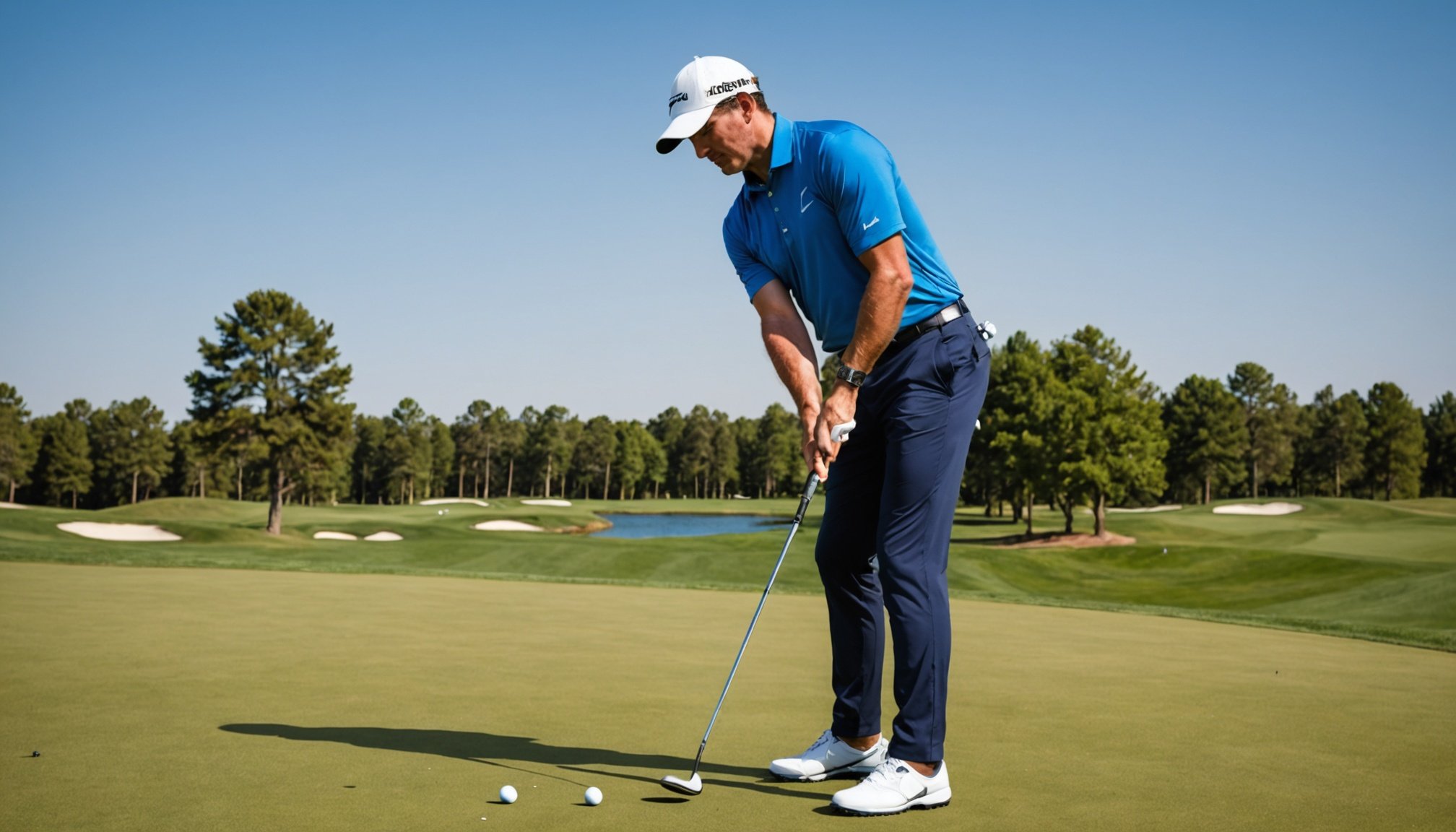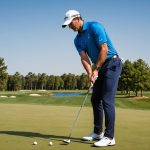Understanding Biomechanics in Golf
Biomechanics plays a crucial role in achieving optimal golf performance and injury prevention. By studying how the body moves during a golf swing, biomechanics provides insights into improving swing mechanics and reducing the risk of injury. This science applies principles such as force, balance, and motion to enhance a player’s swing efficiency.
Key Biomechanical Principles
Several biomechanical principles impact swing mechanics. For instance, understanding the body’s center of mass and utilizing rotational force can significantly influence the power and accuracy of a swing. Proper weight transfer during the swing also contributes to better performance and addresses common issues like slicing.
Also to see : Master Your Grip: Boost Disc Golf Precision with Pro Tactics
Biomechanics and Injury Reduction
Applying biomechanical principles can help reduce injuries by ensuring optimal body alignment and efficient movement patterns. Correct posture and precise movements lessen the strain on joints and muscles. This conscious integration of biomechanics aids in preventing overuse injuries, which are prevalent in golfers, by ensuring that the swing places minimal stress on the body. Implementing these techniques requires practice but offers substantial benefits in performance and longevity in the game.
Essential Biomechanical Techniques for Golf
Understanding and implementing effective golf techniques is essential for enhancing swing mechanics and achieving efficiency on the course. Quality swing mechanics start with examining the intricate phases of a golf swing—from initial setup to follow-through. Key phases include takeaway, backswing, downswing, and impact, each demanding precise body movements.
In the same genre : Master Pro-Level Training Techniques to Stay Ahead of the Game
Analyzing the Golf Swing Mechanics
Focusing on swing mechanics boosts both performance and efficiency. Flaws often arise from biomechanical misalignments, such as uneven shoulder rotation or improper wrist action. To rectify these, golfers should target muscle groups involved in swing execution through specialized exercises. This approach enhances efficiency by optimizing motion and reducing unnecessary stress on the body.
Key Body Movements for a Successful Swing
A successful swing hinges on coordinated body movements. Key movements include hip rotation for generating power, shoulder alignment for stability, and precise wrist control for impact accuracy. By mastering these, golfers can execute more effective, consistent swings, which translates to improved performance over time.
The Importance of Posture and Alignment
Correct posture and body alignment play a pivotal role in achieving successful swings. Misalignment can lead to common swing faults such as hooking or slicing. Golfers should invest time in corrective measures, focusing on optimizing body posture and alignment to improve overall golfing technique.
Injury Prevention Strategies
In the realm of golf, injury prevention strategies are paramount. By understanding and mitigating the risk of injury, golfers can enjoy the sport longer while maintaining peak performance.
Identifying Common Golf Injuries
Golfers commonly face injuries such as lower back pain, tendonitis in the elbows and shoulders, and wrist strains. Recognising these prevalent issues helps in crafting effective prevention techniques tailored to the needs of both amateurs and seasoned players.
Techniques for Injury Prevention
Implementing strategies that align with biomechanical principles is essential for injury prevention. Techniques include maintaining correct posture, ensuring efficient movements, and incorporating regular rest. Developing a balanced exercise routine that targets flexibility, strength, and endurance further reduces the likelihood of injuries. Regular practice of drills designed to improve balance and body control can also play a crucial role in minimizing injury risks.
Importance of Recovery and Rehabilitation
Investing in proper recovery and rehabilitation practices is critical for long-term health and performance. Implementing a structured post-play routine that includes stretching, hydration, and rest can aid in the healing process. Rehabilitation exercises, alongside professional guidance when necessary, ensure that injuries are managed effectively, facilitating a swift and safe return to the course.
Exercises and Drills to Enhance Performance
Integrating biomechanical exercises into your routine is crucial for boosting performance enhancement in golf. These exercises focus on strengthening muscle groups vital for a powerful and efficient swing. Conditioning the core, hips, and shoulders through specific drills enhances swing mechanics and helps maintain balance. Core rotations and medicine ball throws, for instance, build necessary muscle memory and stability.
Golf drills aimed at improving flexibility and balance directly contribute to better swing mechanics. Stretching exercises that target the hamstrings, quadriceps, and shoulders increase range of motion, allowing for a more fluid swing. Balance drills, such as practicing swings on a balance board, are excellent for refining technique and improving body control.
A structured warm-up routine is essential for injury prevention, preparing muscles and joints for the demands of a round of golf. Warming up with dynamic movements, such as leg swings and arm circles, ensures increased blood flow and reduces stiffness. This not only helps in minimising injury risk but also enhances overall performance by enabling smooth, efficient movement during gameplay. By incorporating these targeted exercises and drills, golfers can significantly improve their game, benefiting both performance and longevity in the sport.
Case Studies and Testimonials
Understanding biomechanics has significantly impacted golf players worldwide, both in terms of performance enhancement and injury prevention. Many amateur golfers have shared their success stories, emphasising how the integration of biomechanical techniques has transformed their game. By analysing their swing mechanics and adopting precise body alignments, these players have reported both improved accuracy and increased power in their shots.
In one testimonial, a golfer detailed how focused attention on hip rotation and posture adjustments helped decrease their handicap by several strokes. This improvement underscores the immense potential of biomechanical insights when applied consistently.
Player testimonials often highlight the value of professional coaching in implementing these changes. Coaches provide tailored guidance, ensuring that players incorporate biomechanical principles correctly into their practice routine. Such personalised training has not only reduced injury risks but also enhanced durability and longevity in the game.
Moreover, case studies illustrate the broader impact of biomechanics on golf performance. By systematically integrating these techniques, golfers have experienced notable success and fewer injuries, echoing a growing consensus in the golfing community about the transformative power of biomechanics.
Resources for Further Learning
For individuals keen on enhancing their understanding of golf coaching and biomechanical training, there are ample educational resources available. Delving into these can help refine techniques, reduce injury, and boost overall performance on the course.
Recommended Books and Articles
Numerous books and articles dissect the role of biomechanics in golf. These texts can provide in-depth explanations of swing mechanics, injury prevention, and performance optimization, essential for any golfer’s library.
Online Courses and Workshops
Online platforms offer a variety of courses focused on golf performance and biomechanics. These programs can cater to different skill levels, providing structured guidance and access to expert insights. Workshops often include interactive elements, allowing participants to practice new skills in real-time under professional supervision.
Coaching Certifications and Programs
For those looking to formalize their expertise, coaching certifications and programs emphasize the intersection of biomechanics and injury prevention. These certifications equip coaches with the skills to help golfers enhance their performance while mitigating risks. By pursuing these resources, players and coaches alike can deepen their knowledge and improve their practice, ensuring sustained success in the sport.











